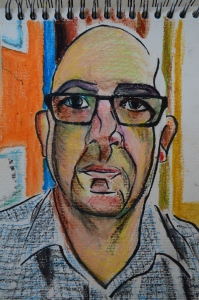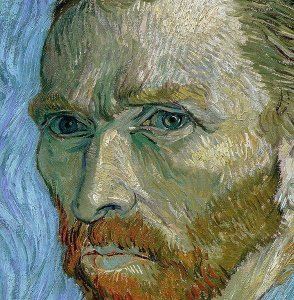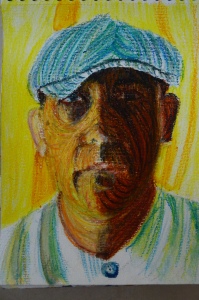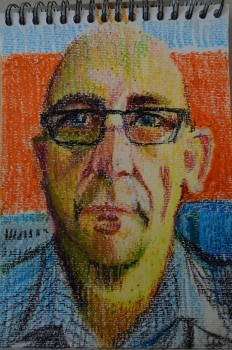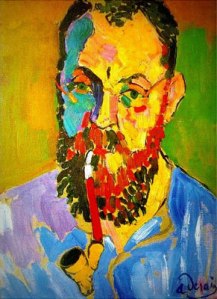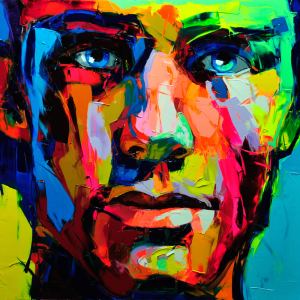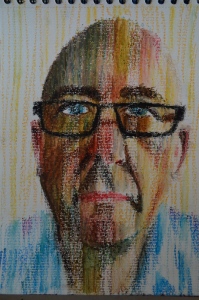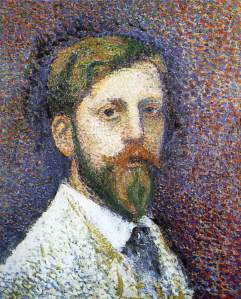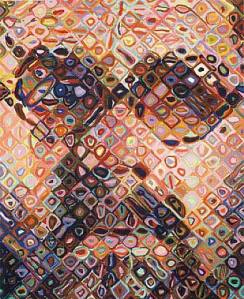For this assignment I chose to paint a self portrait, living alone that seemed to be the best bet. The painting was going to be in acrylics on a canvas panel, I wasn’t going to start using oils this far into the course especially on an assignment piece.
To begin with I began some self portrait studies in the medium I had started to like so much, water soluble oil pastels, these can be used wet or dry so I could do some experimenting with them here.
With the first study I wanted to continue playing around with line like I had in Assignment 2. I began by drawing in the outlines in pencil then drawing over strong outlines with a Pentel brush pen before adding detail and tone in water soluble oil pastels, wet for the face and dry for the clothes. I chose my background wisely with light shining in from a window (at school) and a bright orange picture board. I liked the way the light reflected off my head and used this in the study by leaving that part of my head oil pastel free with the line determining the outline of my head.
Up until now apart from the Conveying Character exercise I hadn’t really included any background in a portrait painting. Would I paint one in the final piece? I’m not sure where this would take me but hopefully the following research would help me to determine that. From here I went on to look at self portraits where the artists used line.
Self Portrait with Line
My search for self-portraits with line took me in a different direction, while I was actually looking for famous self-portraits or portraits that had some kind of outline I came across artists who had created whole paintings using line, such as Vincent van Gogh.
In Self-Portrait 1989 (left) van Gogh uses thick brushstrokes to create a serious weathered look to his face and to depict hair and facial hair. The line he uses for the background is equally important, it turns a plain background into a significant part of this painting.
Nikos Gyftakis, a 33 year old Greek artist, produces some amazing portrait and self-portrait oil paintings where he uses swirls of line to depict depth and contortions in the faces. A number of his portraits include background which he has also used the thick swirls of paint to distort, leaving the viewer to make their own mind up to what is actually in the background.
Self Portrait 1 (right) includes no background whatsoever and the entire canvas is filled up with the face and hands. I love this piece but I have to question, is this technique feasible with acrylic in the short time I have for this assignment? and would it be easy enough to replicate on a smaller canvas?
The next study was a result of this research. Using the same medium I drew myself this time using my hat as a prop using swirls of colour. I kmew I couldn’t replicate the technique perfectly with this medium but I could get some idea as to what the piece would look like in a painting medium such as acrylic or oils.
More Self-Portrait Studies
Moving away from the window I set myself down so that I had the brightly coloured picture board behind me. Inspired by the research into fauvism in the earlier portrait reserach I used quite a limited palette of fairly bright colours and carrying on with more experimentation into using line in my portrait I used only vertical line to complete the picture apart from the check on the shirt.
I really liked the way this turned out, it reminded me of not just the fauve painters’ portraits but with the texture of the paper it kind of reminded me of the pointillist portraits as well.
Fauvist Portraits
Researching fauvism I came across the painters I had researched in the earlier research point such as Henri Matisse as well as some new ones. One fauvist portrait I really liked and in a style that would probably suit the study above was a André Derain’s Portrait of Henri Matisse (1905). I later found out that Derain was the joint founder of Fauvism along side Matisse. His technique in this painting was very crude with what seemed to be a large flat brush and yet parts of the painting could have also been done with a knife. A keyword that I added into my search that took me to an artist that i had never heard of before, palette knife painter Francoise Neilly.
I love French palette knife painter Francoise Neilly’s amazing use of colour and how she uses it not just to depict light and shade but all the features of the face. While searching for a video of her painting I came across another artist named Voka who paints similar portraits but mostly with brushes. The name he uses for his genre of art is spontaneous realism, I’m not sure whether Francoise Neilly would agree it seems like her paintings well thought out.
I looked on the web for amateur artists and students’ work painted in the style of Francoise Neilly and they hadn’t quite managed to pull it off, this made me want to take up the challenge. With the right pose, the right colours and props this style of painting would create a good atmosphere.
I had an idea for my next study but I wasn’t sure how it would turn out. My idea was to complete a self portrait with the dry medium (water soluble oil pastels) and then to work in verticle strips of the portrait with a watercolour brush to see what kind of an effect the water blended pastels had against the dry. A friend said that it looked like water running down a pain of glass but to me something about this painting reminded me of Gerhard Richter’s portraits with the strips of distortions across the face. Although I liked this effect I wasn’t sure how I was going to recreate it with acrylics and so I carried on with my search for portraits using different colour techniques.
Pointillist Portraits
There’s no doubt about it, pointillism is a very time consuming technique I have done a couple of paintings myself using a very crude technique and they took weeks to complete the simplest of paintings so attempting to use it here would slow me right down.
However, the oil pastel on the mixed media paper I was using left white spots and did remind me of pointillism and so there was no harm in taking a look at some of the self portraits and portraits by artists using this technique. One of the strongest of these Self Portraits, other than Vincent van Gogh’s 1887 Self-Portrait was this painting by Georges Lemmen where he seems to use layers and layers of dots that are close knit rather than spaced out like the works of Georges Seurat. This seemed to be a quicker, less time consuming method.
Chuck Close
My research into pointillist self portraits took me to a self portrait by an American Artist called Chuck Close, who actyally suffers from face blindness. When I enlarged the image I realised that it wasn’t a pointillist painting at all but what seemed to be a distorted photo-realist painting.
I was lucky to find a photo of Chuck Close at work, In the photo he was working from a photo of himself on a very large canvas and what he seemed to be doing was adding flesh tones into squares that were already painted with an array of colour and swirls to get this distorted effect that looks like he his behind a pane of patterned glass.
Conclusion
From the research above I concluded that I wouldn’t be painting a background in this self-portrait for assignment 3 but I would be relying on a strong technique to give the painting strength.
I really liked the paintings by Francoise Neilly and I wanted to have a go at something similar myself I just wasn’t sure if:
- Using this technique or at least something similar would demonstrate the skills and knowledge that I have acquired through this part of the course.
- Using a knife with acrylics would create the same affects as a knife with oil paint. Maybe I could use both a knife and a wide brush.
I also loved the technique used by Nikos Gyftakis and the way my self-portrait inspired by his paintings turned out. Out of all the new artists I have found so far he was my favourite. The problem as with Francoise Neilly’s technique how possible would it be to create something similar with acrylics.
What I decided to do was to go into this assignment attempting to create a self portrait inspired by Gyftakis paintings butI would have a back up plan just in case it wasn’t working out. Neilly would be my back up plan.

